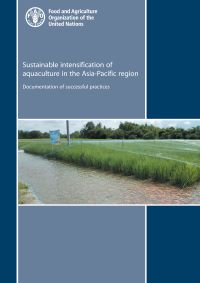Sustainable intensification in aquaculture production: Role of domestication and Selective Breeding
4 March 2013 | Robins McIntosh | 4189 views | .mp4 | 33.52 MB | Genetics and Biodiversity, Environment and Sustainability
The Atlantic salmon, tilapia and whiteleg shrimp (Penaeus vannamei) are the most successful aquaculture species. Fundamental to this success has been the success of genetic improvement of the broodstock. Over the past 20 years, the relative genetic gain in growth rate in aquaculture has far exceeded that in livestock, and resulted in farmed populations with faster growth, more efficient focal conversion ratios (FCRs), and higher levels of disease-resistance.
Selective breeding has taken a sustained long-term effort, increasing in sophistication from the earliest attempts at mass selection and cohort selection, to embrace techniques such as marker-assisted selection/quantitative trait locus mapping (MAS/QTL). Breeding of genetically improved farmed tilapia (GIFT) began only in the 1990s, using eight base populations, four wild (from Egypt, Ghana, Kenya and Senegal) and four farmed (Israel, Singapore, Taiwan Province of China and Thailand). Index selection for five generations in the Philippines from 1990–1996 resulted in accumulative genetic gain of 85 percent. This was followed by 16 generations at the World Fish Center, Malaysia, which brought a further doubling in the selection response. GIFT has since been distributed to 14 countries and accounts for between 30–70 percent of production in Asia.
More intensive aquaculture systems are justified not only for their greater control, reliability or land use efficiency, but also by their enhanced utilisation of genetic potential. However, genetic potential does not automatically translate into performance-systems must be selected to realise the genetic potential of the farmed species.
Genetics are also key to increasing sustainable production of shrimp. The change from P. monodon to P. vannamei was accompanied by intensive selection of P. vannamei; yields increased from 11.95 t/ha/yr in 2002 (monodon) to 52.2 t/ha/yr in 2010 (vannamei), while production costs fell from US$5.27/kg to US$2.45/kg. Domestication has allowed shrimp to be put in ponds with a certainty of health, and with known characteristics. It also provides the base for establishing selective genetic programmes. Domestication was not always high on the agenda; PLs from hatcheries were less sought after than wild PLs. PLs from wild broodstock were accepted but those from a captive source would not be.
In 1996 there was virtually no use of domesticated stocks; Hawaii was the first to develop domesticated specific pathogen free (SPF) white shrimp in response to IHHNV in that state. In 2000 the industry in both the Americas and Asia began to convert; in 2002 only 2–5 percent of Thailand’s industry used domesticated stocks; by 2005 over 90 percent of shrimp culture were from domesticated sources.
At CP the entire shrimp breeding process is done in a nuclear breeding center (NBC) and is fully biosecure. Broodstock is reared on only pelleted diets, using recirculation systems and health monitoring by polymerase chain reaction (PCR). Key traits that can be enhanced are survival (disease resistance), growth rate, salinity tolerance and reproductive fecundity. Growth rate is highly heritable and is key to cost reduction, FCR, time to harvest and survival. Families with best disease tolerance are selected via challenge testing; as a result of continued selective breeding, Taura virus has been eliminated as a disease issue in Thailand.
As mentioned above, realisation of genetic improvement requires control of the pond environment, and sometimes, modification to management practices, especially with regard to biosecurity, oxygen levels, predator/competitor exclusion and pond bottoms. This is only possible under intensive culture conditions.
Overall, domestication and selective genetics have made major contributions to the industry ’s sustainability and profitability. Clean shrimp mean healthy shrimp, reducing pond failures by preventing introduction of viruses or pathogens. Domestication also allows application of the powerful tool of selective genetics, resulting in higher survival and shorter production cycles. Genetic gains have contributed to annual gains in pond efficiency, translating into lower costs of energy, labour, capital and feed costs, combined with higher annual yields.
CP’s vision of sustainability for shrimp is to produce more shrimp from less land, with less energy, with less marine fish inputs, with less feed, with less waste.
Creative Commons Attribution.
